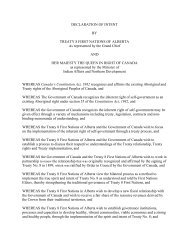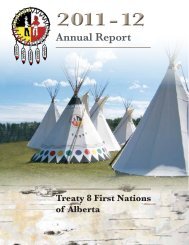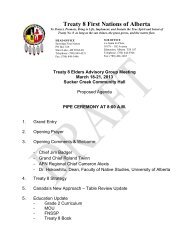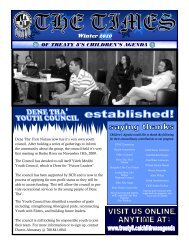Get the 2012-2013 report - Treaty 8 First Nations of Alberta
Get the 2012-2013 report - Treaty 8 First Nations of Alberta
Get the 2012-2013 report - Treaty 8 First Nations of Alberta
You also want an ePaper? Increase the reach of your titles
YUMPU automatically turns print PDFs into web optimized ePapers that Google loves.
Tansi! Daniteh! E’dlanet’e! Hello!<br />
Good day to all <strong>of</strong> our community members <strong>of</strong> <strong>Treaty</strong> 8 <strong>First</strong> <strong>Nations</strong> <strong>of</strong> <strong>Alberta</strong>. The Children’s Agenda has<br />
completed <strong>the</strong> Children’s Agenda Framework, which is now called <strong>the</strong> “Children’s Agenda Model”. From March 1,<br />
2011 – March 31, <strong>2013</strong> Children’s Agenda received funding from Rural <strong>Alberta</strong> Development Fund. The funding<br />
was used to develop a Model that would be more effective in applying culturally relevant methods <strong>of</strong> delivering<br />
services to children and families. During <strong>the</strong> last two years we have worked with three Best Practices Sites,<br />
Sucker Creek <strong>First</strong> <strong>Nations</strong>, Loon River <strong>First</strong> <strong>Nations</strong>, and Bigstone Cree Nation. It was during this time, that<br />
we tested <strong>the</strong> Children’s Agenda Framework, and collected Cultural and Traditional teachings that have been<br />
integrated into <strong>the</strong> Children’s Agenda Model. The completion <strong>of</strong> <strong>the</strong> Model was a long time coming. Since 2003<br />
<strong>the</strong> Elder’s and community members have expressed <strong>the</strong> need to have programs developed specifically for<br />
children, youth and families. On many occasions <strong>the</strong>y expressed a lack <strong>of</strong> parenting programs in <strong>the</strong> communities,<br />
and that <strong>the</strong>re was not enough programs for children and youth.<br />
The Children’s Agenda team listened to our respected <strong>Treaty</strong> 8 Elder’s, community members and leadership.<br />
We wanted to assist in <strong>the</strong> best way that we can to empower our people and to maintain our cultural pride and<br />
identity. We facilitated this process by developing a Children’s Agenda Model that will address <strong>the</strong> immediate<br />
needs and priorities in our communities. The following is <strong>the</strong> Children’s Agenda Model’s Table <strong>of</strong> Contents;<br />
• Children’s Agenda Introduction and History<br />
• Best Practice Site and Lessons Learned<br />
• Traditional Parenting and Teachings/Parenting<br />
handbook<br />
• Cultural Teaching and Programs<br />
Page 34<br />
Children’s Agenda<br />
Ann Nipshank, Children’s Agenda Director<br />
• Development <strong>of</strong> Youth Councils<br />
• Program Implementation<br />
• Jurisdictional Friendly Referral Map and Resource<br />
Manual<br />
Children’s Agenda Introduction and History - is how <strong>the</strong> Children’s Agenda began in 2003 with <strong>the</strong><br />
recommendations and suggestions by <strong>the</strong> community members through <strong>the</strong> community engagement process.<br />
There recommendations were used to develop <strong>the</strong> foundation <strong>of</strong> <strong>the</strong> Children’s Agenda Model.<br />
Best Practice Sites and Lessons Learned - The 9 Best Practice Sites that tested <strong>the</strong> Children’s<br />
Agenda Framework through <strong>the</strong> enhancement <strong>of</strong> existing programs and or creating new programs. This section<br />
will identify <strong>the</strong> challenges, strengths and solutions regarding program implementation.<br />
Traditional Parenting Practices – will reveal <strong>the</strong> traditional Ti-pi teachings, Traditional Child-Rearing<br />
practices, Traditional Family Systems, Four cycles <strong>of</strong> life, Stages <strong>of</strong> Growth, Oral Traditions and Cultural<br />
Teachings.<br />
Cultural Teachings and Programs – This section will explain <strong>the</strong> powwow dance and its cultural<br />
meaning and significance. Cultural programs such as traditional hand games, dance regalia making, and drum<br />
and powwow dance will be highlighted.<br />
Development <strong>of</strong> <strong>the</strong> Youth Council - This section is dedicated to <strong>the</strong> youth. It is a step by step guide<br />
on how to develop youth councils at your <strong>First</strong> Nation.<br />
Program implementation – Is a step by step guide on how to develop programs through <strong>the</strong><br />
implementation process. Program implementation is <strong>the</strong> ability to put your plan into action.<br />
Jurisdictional Friendly Referral Map and Resource Manual – This map and resource manual<br />
is to identify <strong>the</strong> Primary, Secondary, and Tertiary services for health service delivery. It is intended to assist<br />
<strong>First</strong> <strong>Nations</strong> families in gaining better access to health services for <strong>the</strong>ir medically fragile and or special needs<br />
children.















